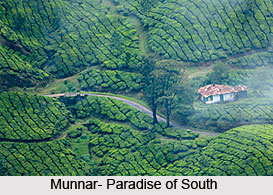 One of the most popular hill stations in India, Munnar is situated at the confluence of three mountain streams - Mudrapuzha, Nallathanni and Kundala. 1600m above sea level, this was once the summer resort of the erstwhile British Government in South India. Sprawling tea plantations, picture book towns. winding lanes, trekking and holiday facilities make Munnar a unique experience. Among the exotic flora found in the forests and grasslands here is the Neelakurinji - a flower which blooms every 12 years and bathes the hills in a blue hue. The Neelakurinji, will bloom next in 2006 AD. Munnar also has the highest peak in South India - Anamudi - Which towers over 2695 m and is an ideal spot for the enthusiastic mountaineer
One of the most popular hill stations in India, Munnar is situated at the confluence of three mountain streams - Mudrapuzha, Nallathanni and Kundala. 1600m above sea level, this was once the summer resort of the erstwhile British Government in South India. Sprawling tea plantations, picture book towns. winding lanes, trekking and holiday facilities make Munnar a unique experience. Among the exotic flora found in the forests and grasslands here is the Neelakurinji - a flower which blooms every 12 years and bathes the hills in a blue hue. The Neelakurinji, will bloom next in 2006 AD. Munnar also has the highest peak in South India - Anamudi - Which towers over 2695 m and is an ideal spot for the enthusiastic mountaineer
Anayirankal (22 kms from Munnar)
It`s a lush green carpet of tea plants. A trip on the splendid reservoir is an unforgettable experience. The Anayirankal dam is surrounded by Tata Tea plantations and evergreen forests. It is an ideal picnic spot.
Top Station (32 kms from Munnar)
1700m above sea level , this is the highest point on the Munnar-Kodiakanal road. The rare Neelakurunji(strobilanthus) belongs to this region. Top Station (a viewing point) also offers a panoramic view of neighbouring state of Tamil nadu.
Mattupetty (13 kms from Munnar)
 Situated at a height of 1700 m ,Mattupetty is famous for its highly specialised dairy farm, the Indo-swiss live stock project. Over 100 varietes of high yeilding cattle are reared here.Visistors are allowed into three of the eleven cattle sheds at the farm. The Mattupetty lake and dam , just a short distance from the farm, is a very beautiful picnic spot. The sprawling Kundala tea plantations and the Kundala lake are other attractions in the vicinity. DTPC Idukki provides boating facilities on the Mattupetty Dam. Speed Launch, slow speed and motor boats are available on hire.
Situated at a height of 1700 m ,Mattupetty is famous for its highly specialised dairy farm, the Indo-swiss live stock project. Over 100 varietes of high yeilding cattle are reared here.Visistors are allowed into three of the eleven cattle sheds at the farm. The Mattupetty lake and dam , just a short distance from the farm, is a very beautiful picnic spot. The sprawling Kundala tea plantations and the Kundala lake are other attractions in the vicinity. DTPC Idukki provides boating facilities on the Mattupetty Dam. Speed Launch, slow speed and motor boats are available on hire.
Devikulam (7 kms from Munnar)
This idylicc hill station with its velvet lawns , exotic flora and fauna and the cool mountain air offers a rare experience to visitors. The Sita Devi lake with its mineral waters and picturesque surroundings is a good picnic spot. The lake is also ideal trout fishing.
Rajamala (15 m from Munnar)
The natural habitat of the Niligiri tahr , Rajamala is 2695 m above sea level. Half the world`s population of the rare mountain goat or tahr (hemitragas hylocres) which is fast becoming extinct, is now found here.The Niligiri tahr in Rajamala are now to be found in small herds found in Eravikulam-Rajamala region. The total number of Niligiri Tahrs in Rajamala is estimated to be over 1300.
Valara (10 kms from Adimali on the Kochi-Madurai highway)
Valara has a chain of waterfalls surrounded by thick green forests.
Marayoor (40 kms from Munnar)
This is the only place in Kerala that has a natural growth of sandalwood trees. The sandalwood factory of the forest department, the caves(muniyaras) with the murals and relics from the New stone age civilization and the children`s park spread across a hectare of land under the canopy of a single banyan tree, are of great interest to tourists. Thoovanam waterfalls and Rajiv Gandhi National PArk are also nearby.



















